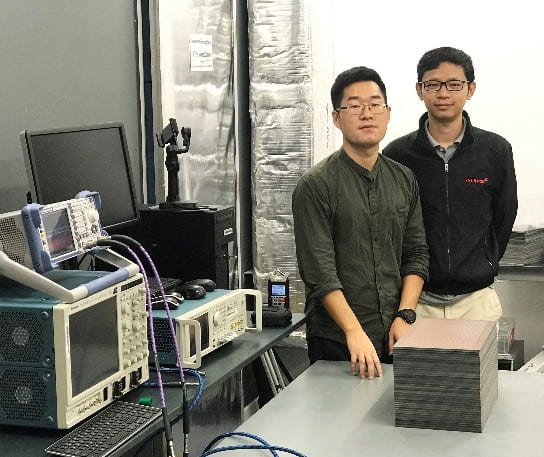
Dr Yihao Yang (left) and Associate Professor Baile Zhang (right), standing behind the three-dimensional photonic topological insulator sample.
Topological insulators are exotic states of matter that physicists have been intensely studying for the past decade. Their most intriguing feature is that they can be rigorously distinguished from all other materials using a mathematical concept known as “topology”. This mathematical property grants topological insulators the ability to transport electric signals without dissipation, via special quantum states called “topological surface states”.
However, topological insulators need not only be realized with electrons. Physicists have also devised “photonic topological insulators”, synthetic materials that impart light waves with distinct topological features, allowing light (rather than electric currents) to flow via topological surface states. Unlike electronic topological insulators, photonic topological insulators can operate easily at room temperature, among other advantages. As a result, photonic topological insulators are currently believed to have applications in future optical devices, such as high-power lasers and optical diodes.
A team of researchers from Nanyang Technological University (NTU), Singapore, and Zhejiang University, China, has now announced the development of the world’s first three-dimensional (3D) photonic topological insulator. In a paper to be published in an upcoming issue of Nature, the team reports that a specially-designed 3D array of resonators can act as a topological insulator for microwaves. They have observed unambiguous evidence for the signature topological surface states, in the form of microwaves that flow effortlessly along 2D sheets embedded within the 3D volume of their sample.
“Previous researchers were able to make two-dimensional photonic topological insulators. But in spite of many theoretical proposals over the years, nobody had been able to realize a 3D version,” says Associate Professor Baile Zhang of NTU, who co-supervised the project. He notes that 3D topological insulators have important capabilities, including the ability to channel topological surface states along all possible spatial directions. In one of their experiments, the researchers showed that microwaves can be guided efficiently along a 2D surface containing zigzag-like folds.
The team constructed the 3D photonic topological insulator out of a stack of thin plastic sheets embedded with metal antennas acting as tiny electromagnetic resonators. The key breakthrough was made when they realized how to tailor the resonators to interact with electromagnetic waves in a very specific way, granting the waves the desired topological characteristics. “Since the sheets are made using well-established technology for printing circuit boards, this design is cheap and simple to implement,” explains Professor Hongsheng Chen of Zhejiang University, another co-supervisor of the project. “By comparison, other proposals previously published in the scientific literature involved using non-standard ceramic or magnetic materials, which are very difficult to work with if you want to make a real device.”
Dr. Yihao Yang, a postdoctoral researcher at NTU who was the lead author on the paper, said that the team was able to build a compelling scientific case by constructing detailed maps of how electromagnetic waves travel within the photonic topological insulator. “By carefully
inserting an electromagnetic field probe into the sample, we measured the field distributions throughout the sample. This allowed us to reconstruct the ‘dispersion relations’ that serve as the physical signatures of topological insulators,” he said.
Associate Professor Yidong Chong, another member of the NTU team, observed that this work is the first realization of a synthetic 3D topological insulator not based on the flow of electric current. “This is an example of the universality of physics,” he said. “A phenomenon arising in one setting, like quantum materials, can be reproduced in another setting, in this case an artificial medium for electromagnetic waves. The key ingredient is that they obey the same equations and
theoretical concepts.” He suggests that the 3D photonic topological insulator may provide an interesting setting for studying fundamental physics, as the topological surface states are governed by the same equations as massless 2D electrons obeying Einstein’s theory of relativity.
The current 3D photonic topological insulator is limited to electromagnetic waves, at relatively low frequencies. “If we can scale it to optical frequencies, that is to say waves of visible
light, there could be applications for creating optical computer chips, lasers, and all sorts of interesting optical devices,” says NTU’s Professor Zhang.
This work has been featured in Nature.
